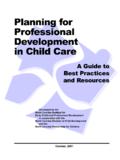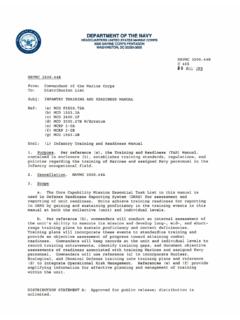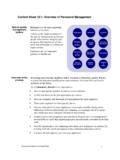Transcription of Developing a Quality Assurance/Quality …
1 Developing a Quality Assurance/Quality improvement framework for Evidence-based ProgramsPhilip McCallion, A. Ferretti, LMSWMari T. Brick, MANACDD/SOPHE Academy and ConferenceAlbuquerque, New Mexico May 2011 The origins and rise of evidence-based programs: what are they?Randomized Control Trials Known as the gold standard for evaluating efficacy of interventions. Randomly assigning subjects to an intervention eliminates any bias from unknown characteristics of the sample that might contribute to treatment effects by balancing these characteristics evenly across intervention groups.
2 Mounting an Intervention RCT StudyStudy DesignRecruitScreenBaseline AssessmentRandomizeTreatmentFollow-up AssessmentFollow-up 2 ControlFollow-up AssessmentFollow-up 2 Model of Influences on Effective Implementation & SustainabilityExtra-Organizational Context( methods of reimbursement, policies)OrganizationalTherapeutic Person FitProcesses Outcomesculture, climate, structureadherence/fidelitysymptoms, functioningIntervention Processestype of treatment, training, supervision, engagement, beliefs, attitudes, valuesPersonal Choice and ControlEmpowerment (knowledge + self-efficacy), engagement, intentions ( , beliefs, attitudes, values)Research Phase Discovery Efficacy Effectiveness/Implementation ResearchTranslation PhaseKnowledge to productsDissemination/ EngagementAdoptionPractice/ Local implementation(Wilson & Fridinger, 2008)
3 Translational Research Type I development and testing of treatment approaches generated through laboratory and pre-clinical research Type II Enhancing the adoption of effective practices in the community What Does Translation Require Real world application Effectiveness Extensiveness Efficacy Engagement in Quality implementation Infrastructure policy, networks and embedding in delivery systems Guidelines, standards and Quality assurance (Adapted from Spoth, 2008) Best Practices Evidence-basedGood ProgrammingBest Practices Processes, practices, or systems widely recognized as improving the performance and efficiency of organizations in a target area, such as health promotion.
4 (NCOA, 2005) Best practices in health promotion are those sets of processes and activities that are consistent with health promotion values/goals/ethics, theories/beliefs, evidence, and understanding of the environment, and that are most likely to achieve health promotion goals in a given situation( )NCOA Model ProgramsPrograms include the essential elements for successful behavior change: goal-setting problem-solving action-planning ongoing support Monitoring*NCOA National Council on AgingNCOA Model ProgramsEffective organizational and program planning strategies for: social marketing staff recruitment and training participant recruitment and retention partnering program sustainability evaluationWhat is Evidence?
5 Lonigan, Ebert & Johnson, 1998; Chamblesset al., 1998At least two controlled group design studies or a large series of single-case design studiesMinimum of two investigators (to be well-established)Use of a treatment manualUniform therapist training and adherenceTested with clinical samplesTests of clinical and functional outcomesLong-term outcomes beyond termination of treatmentGrading the Quality of Evidence:Biglan, Mrazek, Carnine, & Flay (2003) Grades 1-7 1 = multiple RCTs or multiple time series experiments by two or more independent teams + data on implementation effectiveness 2 = multiple RCTs or multiple time series experiments by two or more independent teams 3 = multiple RCTs or multiple time series experiments but no independent teams 4 = 1 RCT or time series 5 = comparisons between groups without randomization 6 = pre-post comparison for one group 7 = endorsement by authoritiesHealth Promotion & Evidence-Based Practice Some are highly rated as evidence-based Many do NOT meet criteria for evidence-based For
6 Others the Quality of the evidence would not be highly of Program/Treatment Fidelity issues is still important Components of an Evidence-Based Health Promotion Program Specific target population Specific, measurable goal(s) Stated reasoning and proven benefits Well-defined program structure and timeframe Specifies staffing needs/skills Specifies facility and equipment needs Builds in program evaluation to measure program Quality and health outcomesNCOA, 2006 Practice opportunity: Case studies Please select a reporter List the essential elements of the program List the organizational and program planning strategies that the program includes Rate the strength of the program based upon the Biglanscale List any other components that contribute to the program s evidence-baseGrading the Quality of Evidence.
7 Biglan, Mrazek, Carnine, & Flay (2003) Grades 1-7 1 = multiple RCTs or multiple time series experiments by two or more independent teams + data on implementation effectiveness 2 = multiple RCTs or multiple time series experiments by two or more independent teams 3 = multiple RCTs or multiple time series experiments but no independent teams 4 = 1 RCT or time series 5 = comparisons between groups without randomization 6 = pre-post comparison for one group 7 = endorsement by authoritiesCase Study A The Arthritis Foundation Exercise Program Essential Elements Organizational and Program Planning Strategies
8 BiglanComparison Other components that contribute to the program s evidence-baseCase Study B The Chronic Disease Self-Management Program Essential Elements Organizational and Program Planning Strategies BiglanComparison Other components that contribute to the program s evidence-baseCase Study C EnhanceFitness Essential Elements Organizational and Program Planning Strategies BiglanComparison Other components that contribute to the program s evidence-baseLet s Take a in 15 minutes pleaseAssuring your program through QA/QI methodsChallenges in the Delivery of Evidence-Based Programs Delivery in original studies was often supervised by the creator Delivery was often by PhD students, research team members and/or other trained practitioners The original manual assumed background knowledge and/or a grounding in professional theories and practices Limited attention paid to treatment fidelity and how it should be measured Translational efforts to date relied heavily upon paid, trained staff or have been under the supervision of the program creatorTranslation for Peers and Communities Delivery needs to move beyond dependence on the supervision of the program creator(s)
9 Delivery cannot assume prior knowledge and professional training of staff nor can it depend on it Training and delivery manuals should clearly specify every step of delivery and every piece of knowledge required for a Quality translation of the programTranslation for Peers and CommunitiesTraining should be standardized: A specific, approved training program for leaders is necessary. A specific, approved train the trainer curriculum is ideal. Both must include guidance on demonstration requirements so that persons may be certified as for Peers and CommunitiesClear guidelines on negotiable and non-negotiable components of the program intervention.
10 What constitutes successful completion of the program/intervention What are successful measures of program/treatment fidelity Translation and Program/Treatment Fidelity The adoption of effective practices in the community and the reliance on volunteers and community practitioners for their delivery requires the separation of the program intervention from clinical and program creator management with the assurance that the intervention will continue to be delivered as intended. How can this be delivered? .. With a focus on effective for Effective Practice Attention to the RE-AIM framework : implementation and maintenance A QA/QI approach An understanding of and a belief in the value of program/treatment fidelityRE-AIM BUILDING BLOCKS THAT TOGETHER PRODUCE PUBLIC HEALTH IMPACTE fficacy EffectivenessReachImplementationMaintena nceBuilding Programs and Policies with a Large Public Health RE-AIM QuestionsImplementation- Can different levels of staff implement the program successfully?








